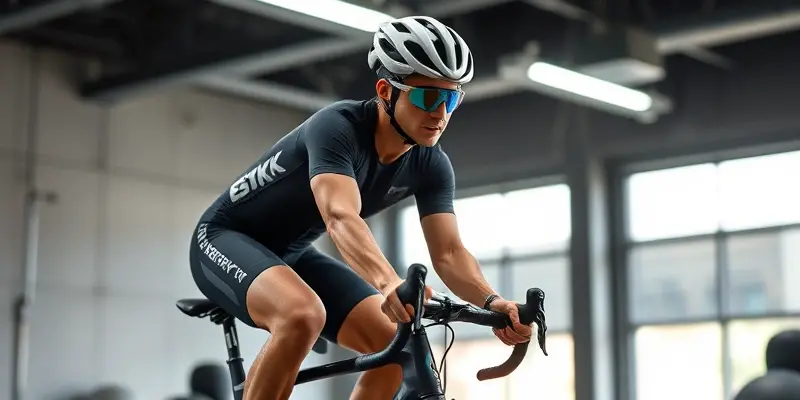Cycling offers incredible health and performance benefits, but it also comes with unique physical demands. Whether you’re a weekend warrior or racing pro, dealing with soreness and avoiding injury are essential for staying in the saddle and enjoying your ride. Today, let’s break down practical, science-backed gym routines designed to keep every cyclist—beginner or advanced—strong, resilient, and motivated.
Why Recovery and Injury Prevention Matter for Cyclists
Ever felt tightness in your knees after a challenging ride, or nagging lower back discomfort after long hours on the bike? You’re not alone. Cycling is repetitive, and without a balanced gym routine, key muscles can weaken or become imbalanced—leading to injury and downtime.
The great news? With a few targeted exercises and smart recovery strategies, you can protect yourself, bounce back faster, and boost your performance.
Understanding Common Cycling Injuries and Their Causes
Let’s start with the challenges most cyclists face:
- Knee pain: Often caused by overuse, weak glutes, or an improper bike fit.
- Lower back pain: A result of core weakness or tight hamstrings from prolonged riding posture.
- Neck and shoulder discomfort: Linked to poor upper body support or posture on the bike.
Why do these happen?
Repetitive movements, muscle imbalances, and a forward-leaning position are the main culprits. Focusing on strength, balance, and flexibility in your gym routine can help address these issues head-on.
Build Your Injury-Proof Gym Routine
Ready to future-proof your cycling? Here’s a simple, beginner-friendly routine that targets key muscles, enhances balance, and reduces injury risk.
Principles to Guide Your Routine
- Strengthen supporting muscles (especially glutes and core)
- Prioritize single-sided (unilateral) and balance work
- Work on upper body endurance and posture support
Warm Up: The Essential Start
Before you hit the weights, get your blood flowing! Try light jogging, leg swings, or bodyweight squats for 10-20 minutes. This primes your joints and prevents injury.
The Must-Do Cycling Strength Circuit
Perform 2–3 times weekly. Focus on slow, controlled movements and good form.
-
Bulgarian Split Squat (10–12 reps per leg)
Targets: Quads, glutes; builds knee/hip stability. -
Glute Bridge (12–15 reps)
Activates glutes, improves hip power—great for explosive pedaling. -
Romanian Deadlift (10–12 reps)
Strengthens hamstrings and lower back, balancing cycling’s quad-dominance. -
Bird-Dog (2 x 10 per side)
Stabilizes the core and back—crucial for posture. -
Plank (Hold 30–60 seconds)
Full core engagement for better riding stability. -
Press-Up (10–15 reps)
Boosts chest and triceps, helping upper body endurance on long rides. -
Triceps Dips (10–12 reps)
Strengthens arms, reducing hand/shoulder fatigue.
Summary Table: Key Exercises and Benefits
| Exercise | Muscle Groups | Injury Prevention Benefit ||——————–|———————|——————————-|| Split Squat | Quads, Glutes | Knee/hip stability || Glute Bridge | Glutes, Hamstrings | Hip power, lower back health || Romanian Deadlift | Hamstrings, Back | Muscle balance || Bird-Dog | Core, Back | Spine stability, balance || Press-Up | Chest, Triceps, Core| Posture, upper body support || Plank | Core | Core strength, posture |
Flexibility, Mobility, and Recovery Best Practices
Stretching Matters
- Before workouts: Use dynamic stretching (leg swings, lunges).
- After workouts: Focus on static stretches for quads, hamstrings, calves, hips, and shoulders to improve mobility and reduce stiffness.
Nutrition for Recovery
- Refuel with protein (20–30g) and carbs post-workout.
- Stay hydrated—dehydration slows muscle repair and saps energy.
- Consider magnesium, iron, and vitamin D to support muscle and overall health.
Smart Recovery Tools
- Try foam rolling or massage guns to ease soreness.
- Use activity trackers to monitor your recovery and spot overtraining early.
Motivation: Mindset During Rehab and Downtime
Stuck on the sidelines? Stay motivated by:
- Setting small, clear goals and tracking progress.
- Celebrating small wins, even a little less pain or an extra rep.
- Practicing mindfulness—focus on what you can do, not just what you can’t.
Visualization and staying engaged with your community or training buddies can provide a huge mental lift. For more on harnessing mental strength during recovery, check out our guide on visualization for healing.
Final Thoughts: Stay Strong, Ride Longer
Investing a few hours each week in off-bike strength and flexibility work can transform your riding experience. Remember, it’s about consistent progress, not perfection. Listen to your body, try the routine above, and enjoy every ride—stronger and more resilient than ever before!
Ready to get started? Let us know your favorite recovery tips or questions in the comments below. Stay healthy and keep pushing forward!
Written by a certified performance coach with a decade of experience helping cyclists and athletes achieve their best. For more science-backed fitness guides, follow Gympulse Club.

